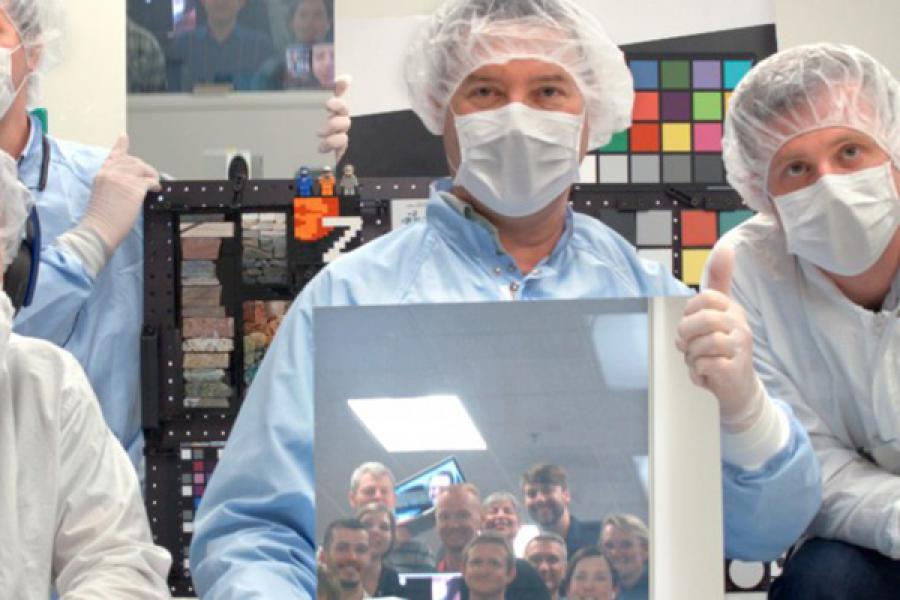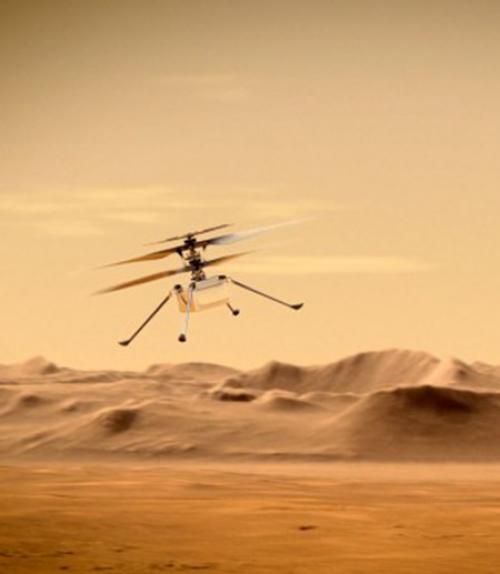Mars is about to become a little more red, thanks to the Cornellians who helped develop and calibrate instruments soon bound for the planet.
Early on July 30, the NASA/Jet Propulsion Lab’s Mars 2020 spacecraft will roar away from Complex 41 at Cape Canaveral Air Force Station, Florida, bound for Earth’s rusty red neighbor.
Cornell researchers are among the hundreds of scientists and engineers who prepared instruments for the Perseverance rover (about the size of a small car) and its accompanying helicopter Ingenuity, which will be aboard the Atlas V-541 rocket.
After a nearly seven-month journey, Perseverance will land in mid-February 2021 on Jezero crater, a location that once featured a large Martian lake.
“Mars 2020 is special because it’s the start of the Mars sample-return campaign,” said Alex Hayes ’03, M.Eng. ’03, associate professor of astronomy in the College of Arts and Sciences, and a co-investigator on Mastcam-Z, the rover’s zoomable mast-mounted camera system.
“According to the current plan, Perseverance will be the first of three missions that NASA and the European Space Agency are sending to the red planet to identify, cache and ultimately return samples back to Earth for study,” Hayes said. “Perseverance, which is built by NASA, will have the job of identifying the samples and deciphering the geologic history of the Jezero crater landing site.”
Jezero crater is an ancient lake basin that contains a delta representing the terminus of a multi-billion-year old river network. While examining the delta and its surroundings, the rover’s sample and caching system will collect core samples of representative rock types and place these materials into hermetically sealed vials that will be left on the planet’s surface to await pickup by a follow-up mission that will return samples to Earth.
That “fetch” rover will be provided by the European Space Agency and will be part of the next phase of the campaign, according to Hayes.
Under the current plan, the ESA Sample Fetch Rover will land at Jezero in August 2028. It will collect the vials and bring them to the NASA-designed Mars-ascent vehicle for a trip off the surface and into Martian orbit.
Like handing a baton to a runner, a third mission will retrieve the samples in Martian orbit and ferry them to Earth for study. The ESA-built Earth-return orbiter – together with NASA’s Earth entry vehicle – will deliver the samples to Earth in spring 2032.
Meanwhile, Cornell scientists and graduate students associated with the project have been busy in the run-up to next week’s launch of Perseverance.
Hayes and senior research associate Rob Sullivan are scientific investigators on the Mastcam-Z team. Doctoral students Megan Barrington, in earth and atmospheric sciences, and Christian Tate, astronomy, and Paul Corlies, Ph.D. ’19, helped calibrate the Mastcam-Z’s stereoscopic and multispectral camera.
Mastcam-Z is the first zoom-capable camera sent to another planet. It will be used to create 3D models of the surface at multiple wavelengths to reveal the terrain’s composition and geology, and help the engineering team guide the rover throughout its exploration area.
Don Banfield, a principal research scientist at Cornell, works on the Mars Environmental Dynamics Analyzer (MEDA) – an instrument that measures wind speed, temperature, humidity and the size of dust particles in the Martian atmosphere. Sullivan is also a member of the MEDA team.
Banfield, who is also the science lead for the meteorological sensors on NASA’s Insight mission, has been selected as a long-term planning lead on Perseverance.
“We’ll actually have InSight [mission rovers] Perseverance and Curiosity operating at the same time on Mars,” Banfield said. “While they are all quite distant from one another on Mars, comparing the ‘weather’ results from all of them will likely prove interesting, similar to how one can learn from looking at the weather in Miami, New York and Tokyo.”
Mike Mellon, principal research scientist at Cornell, is a co-investigator on the Radar Imager for Mars’ Subsurface Experiment (RIMFAX), which will be used to probe below the Martian surface. Radar images will provide context for the sampled rocky outcrops and give a unique view of the region’s buried geological history.
Cornell has long-standing ties to Mars exploration. Late astronomy professor Carl Sagan advised NASA and the Jet Propulsion Laboratory on the Viking Lander missions in the 1970s. Viking 1 landed on Mars July 4, 1976 – the United States’ bicentennial.
Steve W. Squyres ’78, Ph.D. ’81, professor emeritus in astronomy, served as the principal investigator for the Mars Exploration Rovers scientific mission, launched in the summer of 2003. Twin rovers Spirit and Opportunity explored the red landscape starting in early 2004.
Jim Bell, an astronomy professor at Arizona State University and adjunct professor of astronomy at Cornell, is principal investigator for Perseverance’s Mastcam-Z. He served as the principal investigator for the panoramic camera, or PanCam, on Spirit and Opportunity while at Cornell.
For Hayes, working on Perseverance has been a homecoming. In the late 1990s, as a high school student from Centereach, Long Island, he wrote to Squyres to learn about space science opportunities for undergraduates at Cornell. Squyres invited Hayes to the Mars team, where he conducted research for Spirit and Opportunity missions throughout his time as a Cornell undergraduate and master’s student.
For Barrington, from Brownwood, Texas, the launch is a dream. It’s her first mission, “so it holds a very unique spot in my heart,” she said. “There is a lot of personal gratification that comes from being able to witness the launch and watch this [Mastcam-Z] instrument … launch into space and head off to another world. It’s pure joy on my end.”
Read the story in the Cornell Chronicle.





